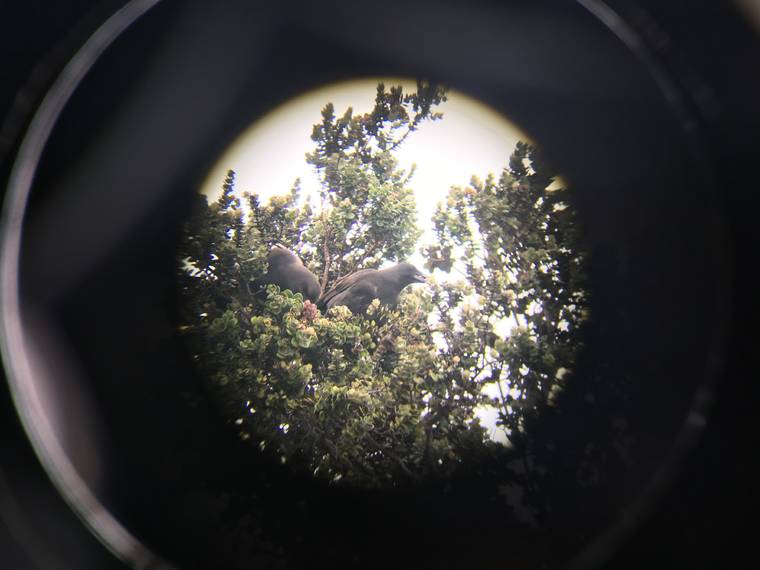No sign of chicks from ‘alala pair
The first breeding attempt by a pair of Hawaiian crows in the wild in nearly 20 years appears to have been a failure.
Earlier this month, two Hawaiian crows — or ‘alala — named Mana‘olana and Manaiakalani displayed behavior associated with egg incubation on a nest they built in the Pu‘u Maka‘ala Natural Area Reserve, leading researchers to think the birds laid a clutch of eggs.
ADVERTISING
However, no signs of chicks have been detected from the nest well past the point when any eggs would be expected to hatch, said Rachel Kingsley, education and outreach associate for The ‘Alala Project, a joint effort between the state Department of Land and Natural Resources, the U.S. Fish and Wildlife Service and San Diego Zoo Global to revitalize the critically endangered species.
“Unfortunately, we believe they are not going to hatch,” Kingsley said.
The two crows are members of an 11-‘alala cohort released into the wild in 2017. Since then, the number of ‘alala in the wild has grown to 21, with The ‘Alala Project planning to release more this year.
Although researchers have still been unable to confirm the presence of eggs within the nest, Manaiakalani — the female of the pair — has perched on the nest as though incubating a clutch for weeks, and continues to do so. Kingsley said it is not unusual for ‘alala to remain perched on infertile or otherwise nonviable eggs.
“They’ll keep doing that until they realize they won’t hatch,” Kingsley said.
Infertile eggs are not uncommon among first-time ‘alala breeding pairs, Kingsley said, but the eggs also could have been killed by factors such as improper incubation or cold temperatures.
“And sometimes, eggs just die,” Kingsley said.
Kingsley said while it is uncertain when the incubation started, she is doubtful any eggs could still be viable after so much time.
Even had the eggs successfully hatched, few of the chicks would likely survive. Kingsley said typical clutches range from two to five eggs, but usually only two of the hatchlings would survive to become fledglings.
When the birds eventually do give up on this clutch of eggs, Kingsley said it is “iffy” whether they will try again within the year. The ‘alala could retry again within some weeks, but Kingsley said it depends on the particular breeding pair. Because this was the pair’s first attempt, she said she would not expect them to try again this breeding season.
While these eggs were the first ones to be produced by a breeding pair in the wild since the species went extinct in the wild nearly 20 years ago, Kingsley said two other pairs of crows appear to be in the process of building nests of their own. One pair might be ready to begin breeding within the next few weeks.
“We’re still hopeful that the other ones can do it,” Kingsley said.
Email Michael Brestovansky at mbrestovansky@hawaiitribune-herald.com.


